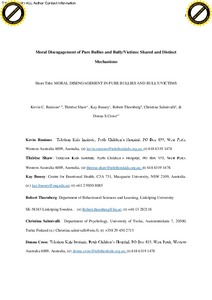Moral Disengagement of Pure Bullies and Bully/Victims: Shared and Distinct Mechanisms
Shaw Thérèse; Salmivalli Christina; Bussey Kay; Cross Donna S.; Thornberg Robert; Runions Kevin C.
https://urn.fi/URN:NBN:fi-fe2021042822464
Tiivistelmä
The vast majority of adolescents recognize that bullying is morally
wrong, yet bullying remains a problem in secondary schools, indicating
young people may disengage from their moral values to engage in
bullying. But it is unclear whether the same mechanisms enabling moral
disengagement are active for bully/victims (who both bully and are
bullied) as for pure bullies (who are not targets of bullying). This
study tested the hypotheses that mechanisms of moral disengagement,
including blaming the victim and minimizing the impact of bullying, may
operate differently in bully/victims compared to pure bullies. From a
sample of 1895 students from grades 7–9 (50.6% female; 83.4% from
English speaking homes), 1870 provided self-reports on bullying
involvement and mechanisms of moral disengagement associated with
bullying. Two cut-offs were compared for bullying involvement (as
perpetrator and as target of bullying) during the previous school term: a
conservative cut-off (every few weeks or more often) and a liberal
cut-off (once-or-twice). Using the conservative cut-off, both pure
bullies and bully/victims enlisted moral disengagement mechanisms to
justify bullying more than did uninvolved students and pure victims,
with no significant difference in scores on any of the moral
disengagement scales between pure bullies and bully/victims. For the
liberal cut-off, bully/victims reported lower overall moral
disengagement scores than did pure bullies, and specifically less
distortion of consequences, diffusion of responsibility, and euphemistic
labeling. This study advances bullying research by extending the role
of moral disengagement in bullying episodes beyond pure bullies to
victims, both pure victims and bully/victims. Examination of specific
moral disengagement mechanisms and the extent of involvement in bullying
enabled a more nuanced differentiation between the bullying groups.
These results will inform future interventions aimed at reducing the use
of moral disengagement mechanisms that sustain bullying and
victimization. Targeted interventions are needed to challenge specific
moral disengagement mechanisms from the perspectives of pure bullies and
bully/victims.
Kokoelmat
- Rinnakkaistallenteet [19207]
